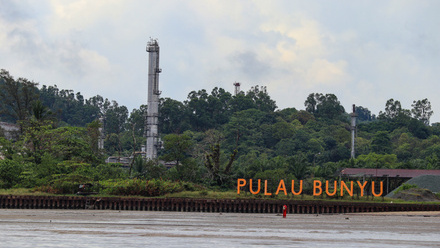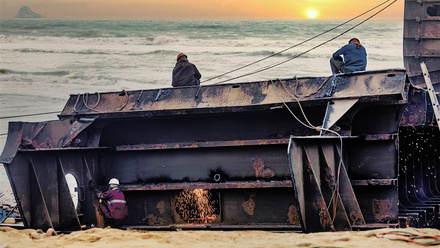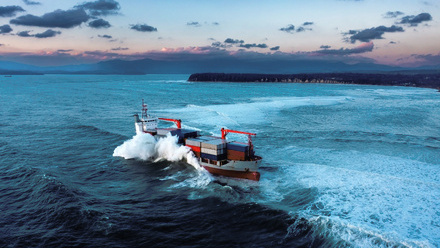‘Alarm fatigue’ and lack of training results in MPV Everest fire
Blaze engulfs engine room, destroying two inflatable boats back in early 2021.
Every ship is a prototype – even successive sister ships built in the same yard – and though this is often talked about, it is not often acted upon.
On the bridge, equipment from different original equipment manufacturers (OEMs) is connected, sometimes integrated in suboptimal fashion.
But since none of its OEMs want their equipment to be the one responsible for an accident, the phenomenon of ‘alarm fatigue’ arises. Used to dismissing hundreds of irrelevant alarms per day, ship crews become accustomed to them. If the ship is in supposed mortal danger every few minutes, then it probably isn’t and, in the meantime, crew would just prefer the incessant ringing to stop.
Plying Antarctic waters in early 2021, the crew of Bahamas-flagged MPV Everest encountered more than a hundred alarms per day. Rolling movements generated by heavy weather, and the sloshing of ballast water and fuel, had been tripping their respective tanks’ high-level sensors for days.
So, when on 5 April with over 100 souls aboard, more high-level tank alarms began to sound from the ship’s fuel oil settling tank and drain tanks, the crew likely gave this scant consideration. Some 197 alarms had sounded the previous day – one every seven minutes. Unfortunately, this time, they were real.
What happened on the day
At 9:26am, following the failure of generator DG4 in the small hours of the morning thanks to a broken crankshaft, engineering staff made the decision to transfer the fuel in its corresponding No.4 fuel tank into the port settling tank. The chief engineer activated a transfer using the vessel’s integrated automation systems (IAS), and the tank began to fill.
By 10:02am, while MPV Everest was around 1,200 miles north-east of Mawson station, Antarctica, on a course toward Hobart, Australia, its port settling tank had reached 85%, and an alarm sounded. The crew ignored it. By 10:18am, the tank was 90% full, and overflowing into the port drain tank. By 10:31am, another alarm sounded to warn that the latter tank was 50% full; the crew again ignored it. By 10:43am, the port drain tank was full, and began to back up into the settling tank.
Pressure increased, the tank continued to fill, and once it was full, fuel oil began to climb a pipe at the top of the tank, which served as an air vent. As fuel erupted from the end of the pipe several decks above, it spilled down into the engine room from above, and onto the exhaust trunking of the still-operational DG3 generator.
In the chaos that followed, flames erupted inside the vessel’s port-side exhaust casing, shooting out from the ventilation louvres. As the crew noticed the flames, alarms began to blare, and the water mist system started up.
With the exhaust casing heating up dramatically, lifeboats outside the casing began to melt. With the crew battling the flames, DG2 and DG3 were shut down and the ventilation cut off to starve the fire. The vessel’s electrical load, now including firefighting equipment, shared a diminishing number of generators, with three offline.
At 11:06am, DG6 generator, in the starboard engine room, shut down from overloading, taking with it the vessel’s propulsion and fire pumps, and leaving it dead in the water. Function was not restored until some minutes later, when the chief engineer had to manually reactivate the water mist system.
What followed was a sequence of generator mishaps which lasted nearly an hour, after which point, DG6 was pressed back into service, and the water misting system activated. Personnel continued to battle the flames until the fire was declared out at 14:34pm.
Outcomes and lessons learned
In the aftermath of the incident, the Australian Transport Safety Bureau (ATSB) determined that manager Fox Offshore: “Had not ensured that the ship was adequately manned, equipped or prepared for the hazards of operations in the Southern Ocean and Antarctica.”
Much of the ATSB post-mortem placed an emphasis on shortcomings in crew training. “With a few exceptions, all the officers and crew who joined the ship for the duration of the AAD charter, were new to the ship.
“Consequently, when the fire broke out, most of the ship’s officers and engineers, including the master and chief engineer, had not participated in an engine room fire drill on board the ship,” the report determined.
But as is often the case, the fire on MPV Everest was deemed to have been caused by many systemic defects happening to line up. Among these were various concerns with the ship’s firefighting system, but featured prominently also were understaffing and overwork, ATSB found.
“Inappropriate engineering watchkeeping practices on board, influenced by factors such as workload, crewing, and the characteristics of the ship’s IAS reduced the effectiveness of this system and increased the risk that appropriate personnel would not be alerted to engineering conditions and events requiring attention,” wrote ATSB.
Far from insuring against risk by over-alerting and alarm fatigue, OEMs could be putting lives in danger at times when alarm really does need to be raised. Operating in the polar regions will always be dangerous, but as MPV Everest demonstrates, ships must be safer before they get there.
Main image: Antarctic waters as seen from a ship; credit: Shutterstock






